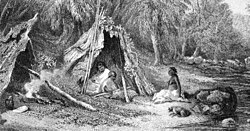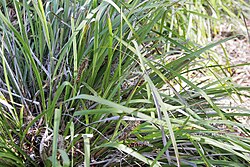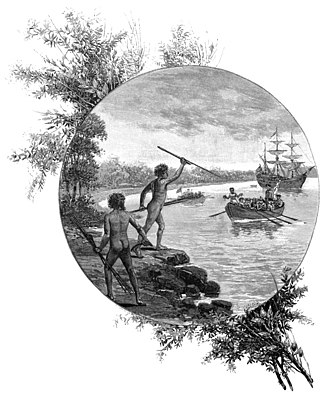Difference between revisions of "AY Honors/Aboriginal Lore/Answer Key"
| Line 6: | Line 6: | ||
===Migration to Australia=== | ===Migration to Australia=== | ||
| − | It is believed that first [[human migration]] to Australia was achieved when this landmass formed part of the [[Sahul]] continent, connected to the island of [[New Guinea]] via a [[land bridge]]. It is also possible that people came by boat across the [[Timor Sea]]. The exact timing of the arrival of the ancestors of the Indigenous Australians has been a matter of dispute among archaeologists. The most generally accepted date for first arrival is between 40,000 - 50,000 years [[Before Present|BP]]. In 1971 finds of Aboriginal stone tools in a quarry in Penrith in New South Wales were dated to 47,000 years BP<ref>[http://users.orac.net.au/~mhumphry/aborigin.html]</ref>. A 48,000 BC date is based on a few sites in northern Australia dated using [[thermoluminescence]]. A large number of sites have been [[Radiocarbon dating|radiocarbon dated]] to around 38,000 BC, leading some researchers to doubt the accuracy of the thermoluminescence technique. Some estimates have been given as widely as from 30,000 to 68,000 BC.<ref>[http://www.nature.com/nature/journal/v421/n6925/abs/nature01383.html Bowler, JM et al, (20 February 2003), ''Letters: New ages for human occupation and climatic change at Lake Mungo, Australia'', '''Nature''' 421, pp. 837-840]</ref> | + | It is believed that first [[human migration]] to Australia was achieved when this landmass formed part of the [[Sahul]] continent, connected to the island of [[New Guinea]] via a [[land bridge]]. It is also possible that people came by boat across the [[Timor Sea]]. The exact timing of the arrival of the ancestors of the Indigenous Australians has been a matter of dispute among archaeologists. The most generally accepted date for first arrival is between 40,000 - 50,000 years [[Before Present|BP]]. In 1971 finds of Aboriginal stone tools in a quarry in Penrith in New South Wales were dated to 47,000 years BP<ref>[http://users.orac.net.au/~mhumphry/aborigin.html]</ref>. A 48,000 BC date is based on a few sites in northern Australia dated using [[thermoluminescence]]. A large number of sites have been [[Radiocarbon dating|radiocarbon dated]] to around 38,000 BC, leading some researchers to doubt the accuracy of the thermoluminescence technique. Radiocarbon dating is limited to a maximum age of around 40 000 years. Some estimates have been given as widely as from 30,000 to 68,000 BC.<ref>[http://www.nature.com/nature/journal/v421/n6925/abs/nature01383.html Bowler, JM et al, (20 February 2003), ''Letters: New ages for human occupation and climatic change at Lake Mungo, Australia'', '''Nature''' 421, pp. 837-840]</ref> Earlier dates are requiring new techniques such as [[optically stimulated luminescence]] (OSL) [[and accelerator mass spectrometry]] (AMS), and the evidence for an earlier date for arrival is growing. Charles Dortch has dated recent finds on Rottnest Island, Western Australia at 70,000 years BP <ref>Dortch, C.E. and Hesp, P.A. 1994. "Rottnest Island artifacts and palaeosols in the context of Greater Swan Region prehistory" (Journal of the Royal Society of Western Australia 77:23-32)</ref>. The rock shelters at Malakunanja II is a shallow rock-shelter about 50 kilometres inland from the present coast, while the rock-shelter of Nauwalabila I 70 kilometers further south show evidence of used pieces of ochre - evidence for paint used by artists 60,000 years ago. Using OSL Rhys Jones has obtained a date for stone tools in these horizons dating from 53-60,000 years ago<ref>[http://www.aboriginalartonline.com/art/rockage.php]</ref>. |
[[Thermoluminescence dating]] of the Jinmium site in the [[Northern Territory]] suggested a date of 200,000 BC. Although this result received wide press coverage, it is not accepted by most archaeologists. Only [[Africa]] has older physical evidence of habitation by [[modern human]]s. | [[Thermoluminescence dating]] of the Jinmium site in the [[Northern Territory]] suggested a date of 200,000 BC. Although this result received wide press coverage, it is not accepted by most archaeologists. Only [[Africa]] has older physical evidence of habitation by [[modern human]]s. | ||
Revision as of 05:54, 19 January 2007
Origins
The minimum widely-accepted timeframe for the arrival of humans in Australia places this at 40,000 to 45,000 years ago. The upper range supported by others is up to 70,000 years ago. There is no clear or accepted origin of the indigenous people of Australia. Although they migrated to Australia through Southeast Asia they are not demonstrably related to any known Asian or Polynesian population. There is evidence of genetic and linguistic interchange between Australians in the far north and the Austronesian peoples of modern-day New Guinea and the islands, but this may be the result of recent trade and intermarriage.&
Migration to Australia
It is believed that first human migration to Australia was achieved when this landmass formed part of the Sahul continent, connected to the island of New Guinea via a land bridge. It is also possible that people came by boat across the Timor Sea. The exact timing of the arrival of the ancestors of the Indigenous Australians has been a matter of dispute among archaeologists. The most generally accepted date for first arrival is between 40,000 - 50,000 years BP. In 1971 finds of Aboriginal stone tools in a quarry in Penrith in New South Wales were dated to 47,000 years BP&. A 48,000 BC date is based on a few sites in northern Australia dated using thermoluminescence. A large number of sites have been radiocarbon dated to around 38,000 BC, leading some researchers to doubt the accuracy of the thermoluminescence technique. Radiocarbon dating is limited to a maximum age of around 40 000 years. Some estimates have been given as widely as from 30,000 to 68,000 BC.& Earlier dates are requiring new techniques such as optically stimulated luminescence (OSL) and accelerator mass spectrometry (AMS), and the evidence for an earlier date for arrival is growing. Charles Dortch has dated recent finds on Rottnest Island, Western Australia at 70,000 years BP &. The rock shelters at Malakunanja II is a shallow rock-shelter about 50 kilometres inland from the present coast, while the rock-shelter of Nauwalabila I 70 kilometers further south show evidence of used pieces of ochre - evidence for paint used by artists 60,000 years ago. Using OSL Rhys Jones has obtained a date for stone tools in these horizons dating from 53-60,000 years ago&.
Thermoluminescence dating of the Jinmium site in the Northern Territory suggested a date of 200,000 BC. Although this result received wide press coverage, it is not accepted by most archaeologists. Only Africa has older physical evidence of habitation by modern humans.
Humans reached Tasmania approximately 40,000 years ago by migrating across a land bridge from the mainland that existed during the last ice age. After the seas rose about 12,000 years ago and covered the land bridge, the inhabitants there were isolated from the mainland until the arrival of European settlers.&
Mungo Man, whose remains were discovered in 1974 near Lake Mungo in New South Wales, is the oldest human yet found in Australia. Although the exact age of Mungo Man is in dispute, the best consensus is that he is at least 40,000 years old. Stone tools also found at Lake Mungo have been estimated, based on stratigraphic association to be about 50,000 years old. Since Lake Mungo is in south-eastern Australia, many archaeologists have concluded that humans must have arrived in north-west Australia at least several thousand years earlier.
Before European arrival
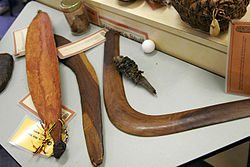
At the time of first European contact, it is estimated that between 250,000 and 1 million people lived in Australia. Population levels are likely to have been largely stable for many thousands of years. The common perception that indigenous Australians were primarily desert dwellers is false: the regions of heaviest Indigenous population were the same temperate coastal regions that are currently the most heavily populated. The greatest population density was to be found in the southern and eastern regions of the continent, the Murray River valley in particular. However, indigenous Australians maintained successful communities throughout Australia, from the cold and wet highlands of Tasmania to the more arid parts of the continental interior. In all instances, technologies, diets and hunting practices varied according to the local environment.
Post-colonisation, the coastal indigenous populations were soon absorbed, depleted or forced from their lands; the traditional aspects of Aboriginal life which remained persisted most strongly in areas such as the Great Sandy Desert where European settlement has been sparse.
The mode of life and material cultures varied greatly from region to region. While Torres Strait Island populations were agriculturalists who supplemented their diet through the acquisition of wild foods the remainder of Indigenous Australians were hunter-gatherers. Indigenous Australians along the coast and rivers were also expert fishermen. Some Aborigines and Torres Strait Islanders relied on the dingo as a companion animal, using it to assist with hunting and for warmth on cold nights.
Some writers have described some mainland Indigenous food and landscape management practices as "incipient agriculture" Template:Fact. In present-day Victoria, for example, there were two separate communities with an economy based on eel-farming in complex and extensive irrigated pond systems; one on the Murray River in the state's north, the other in the south-west near Hamilton, which traded with other groups from as far away as the Melbourne area (see Gunditjmara).
On mainland Australia no animal other than the dingo, was domesticated, however domestic pigs were utilised by Torres Strait Islanders. The typical Indigenous diet included a wide variety of foods, such as pig, kangaroo, emu, wombats, goanna, snakes, birds, many insects such as honey ants and witchetty grubs. Many varieties of plant foods such as taro, coconuts, nuts, fruits and berries were also eaten.
A primary tool used in hunting is the spear, launched by a woomera or spear-thrower in some locals. Boomerangs were also used by some mainland Indigenous peoples. The non-returnable boomerang (known more correctly as a Throwing Stick), more powerful than the returning kind, could be used to injure or even kill a kangaroo.
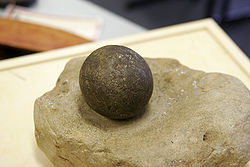
Permanent villages were the norm for most Torres Strait Island communities. In some areas mainland Indigenous Australians also lived in semi-permanent villages, most usually in less arid areas where fishing could provide for a more settled existence. Most Indigenous communities were semi-nomadic, moving in a regular cycle over a defined territory, following seasonal food sources and returning to the same places at the same time each year. From the examination of middens, archaeologists have shown that some localities were visited annually by Indigenous communities for thousands of years. In the more arid areas Indigenous Australians were nomadicTemplate:Fact, ranging over wide areas in search of scarce food resources.
The Indigenous Australians lived through great climatic changes and adapted successfully to their changing physical environment. There is much ongoing debate about the degree to which they modified the environment. One controversy revolves around the role of Indigenous people in the extinction of the marsupial megafauna (also see Australian megafauna). Some argue that natural climate change killed the megafauna. Others claim that, because the megafauna were large and slow, they were easy prey for human hunters. A third possibility is that human modification of the environment, particularly through the use of fire, indirectly led to their extinction.
Indigenous Australians used fire for a variety of purposes: to encourage the growth of edible plants and fodder for prey; to reduce the risk of catastrophic bushfires; to make travel easier; to eliminate pests; for ceremonial purposes; for warfare and just to "clean up country." There is disagreement, however, about the extent to which this burning led to large-scale changes in vegetation patterns.
There is evidence of substantial change in Indigenous culture over time. Rock painting at several locations in northern Australia has been shown to consist of a sequence of different styles linked to different historical periods.
Some have suggested, for instance that the Last Glacial Maximum, of 20,000 years ago, associated with a period of continental wide aridity and the spread of sand-dunes, was also associated with a reduction in Aboriginal activity, and greater specialisation in the use of natural foodstuffs and products. The Flandrian Transgression associated with sea-level rise, particularly in the north, with the loss of the Sahul Shelf, and with the flooding of Bass Strait and the subsequent isolation of Tasmania, may also have been periods of difficulty for affected groups.
Harry Lourandos has been the leading proponent of the theory that a period of hunter-gatherer intensification occurred between 3000 and 1000 BC. Intensification involved an increase in human manipulation of the environment (for example, the construction of eel traps in Victoria), population growth, an increase in trade between groups, a more elaborate social structure, and other cultural changes. A shift in stone tool technology, involving the development of smaller and more intricate points and scrapers, occurred around this time. This was probably also associated with the introduction to the mainland of the Australian dingo.
Many Indigenous communities also have a very complex kinship structure and in some places strict rules about marriage. In traditional societies, men are required to marry women of a specific moiety. The system is still alive in many Central Australian communities. —To enable men and women to find suitable partners, many groups would come together for annual gatherings (commonly known as corroborees) at which goods were traded, news exchanged, and marriages arranged amid appropriate ceremonies. This practice both reinforced clan relationships and prevented inbreeding in a society based on small semi-nomadic groups.
The historical record tends to favour distinct and widespread evidence of cannibalism in Indigenous communities. That the practice was observed by anthropologists from the time of European settlement and well into the 20th century has been noted by a number of writers, including W.E. Roth in his monumental study "The Queensland Aborigines".
Impact of European settlement
In 1770, Lieutenant James Cook took possession of the east coast of Australia in the name of Great Britain and named it New South Wales. British colonisation of Australia began in Sydney in 1788. The most immediate consequence of British settlement - within weeks of the first colonists' arrival - was a wave of European epidemic diseases such as chickenpox, smallpox, influenza and measles, which spread in advance of the frontier of settlement. The worst-hit communities were the ones with the greatest population densities, where disease could spread more readily. In the arid centre of the continent, where small communities were spread over a vast area, the population decline was less marked.
The second consequence of British settlement was appropriation of land and water resources. The settlers took the view that Indigenous Australians were nomads with no concept of land ownership, who could be driven off land wanted for farming or grazing and who would be just as happy somewhere else. In fact the loss of traditional lands, food sources and water resources was usually fatal, particularly to communities already weakened by disease. Additionally, Indigenous Australians groups had a deep spiritual and cultural connection to the land, so that in being forced to move away from traditional areas, cultural and spiritual practices necessary to the cohesion and well-being of the group could not be maintained. Proximity to settlers also brought venereal disease, to which Indigenous Australians had no tolerance and which greatly reduced indigenous fertility and birthrates. Settlers also brought alcohol, opium and tobacco and Substance abuse has remained a chronic problem for indigenous communities ever since. The combination of disease, loss of land and direct violence reduced the Aboriginal population by an estimated 90% between 1788 and 1900. Entire communities in the moderately fertile southern part of the continent simply vanished without trace, often before European settlers arrived or recorded their existence. The indigenous people in Tasmania were particularly hard-hit, with the last full-blood indigenous Tasmanian, Truganini, dying in 1876, although a substantial part-indigenous community survived.
Dr Lang said "There is black blood at this moment on the hands of individuals of good repute in the colony of New South Wales of which all the waters of New Holland would be insufficient to wash out the indelible stains." &
A wave of massacres and resistance also followed the frontier of European settlement. In 1838, twenty eight indigenous people were killed at the Myall Creek massacre and the hanging of the white convict settlers responsible was the first time whites had been executed for the murder of indigenous people. Many indigenous communities resisted the settlers, such as the Noongar of south-western Australia, led by Yagan, who was killed in 1833. The Kalkadoon of Queensland also resisted the settlers, and there was a massacre of over 200 people on their land at Battle Mountain in 1884. There was a massacre at Coniston in the Northern Territory in 1928. Poisoning of food and water has been recorded on several different occasions. The number of violent deaths at the hands of white people is still the subject of debate, with a figure of around 10,000 - 20,000 deaths being advanced by historians such as Henry Reynolds. Nevertheless, disease and dispossession were always the major causes of indigenous deaths. By the 1870s all the fertile areas of Australia had been appropriated, and indigenous communities reduced to impoverished remnants living either on the fringes of European communities or on lands considered unsuitable for settlement.
Some initial contact between indigenous people and Europeans was peaceful, starting with the Guugu Yimithirr people who met James Cook near Cooktown in 1770. Bennelong served as interlocutor between the Eora people of Sydney and the British colony, and was the first Indigenous Australian to travel to England, staying there between 1792 and 1795. Indigenous people were known to help European explorers, such as John King, who lived with a tribe for two and a half months after the ill fated Burke and Wills expedition of 1861. Also living with indigenous people was William Buckley, an escaped convict, who was with the Wautharong people near Melbourne for thirty-two years, before being found in 1835. Many indigenous people adapted to European culture, working as stock hands or labourers. The first Australian cricket team, which toured England in 1867, was made up of indigenous players.

As the European pastoral industries developed, several economic changes came about. The appropriation of prime land and the spread of European livestock over vast areas made a traditional indigenous lifestyle less viable, but also provided a ready alternative supply of fresh meat for those prepared to incur the settlers' anger by hunting livestock. The impact of disease and the settlers' industries had a profound impact on the Indigenous Australians' way of life. With the exception of a few in the remote interior, all surviving indigenous communities gradually became dependent on the settler population for their livelihood. In south-eastern Australia, during the 1850s, large numbers of white pastoral workers deserted employment on stations for the Australian goldrushes. Indigenous women, men and children became a significant source of labour. Most indigenous labour was unpaid, instead indigenous workers received rations in the form of food, clothing and other basic necessities. In the later 19th century, settlers made their way north and into the interior, appropriating small but vital parts of the land for their own exclusive use (waterholes and soaks in particular), and introducing sheep, rabbits and cattle, all three of which ate out previously fertile areas and degraded the ability of the land to carry the native animals that were vital to indigenous economies. Indigenous hunters would often spear sheep and cattle, incurring the wrath of graziers, after they replaced the native animals as a food source. As large sheep and cattle stations came to dominate northern Australia, indigenous workers were quickly recruited. Several other outback industries, notably pearling, also employed Aboriginal workers. In many areas Christian missions also provided food and clothing for indigenous communities, and also opened schools and orphanages for indigenous children. In some places colonial governments also provided some resources. Nevertheless, some indigenous communities in the most arid areas survived with their traditional lifestyles intact as late as the 1930s.
In general, the first European colonisers were at least not opposed Template:Fact, but there were violent conflicts from time to time frequently culminating in killings. In the Northern Territory, both isolated Europeans (usually travellers) and visiting Japanese fishermen continued to be speared to death occasionally until the start of the Second World War in 1939. It is known that some European settlers in the centre and north of the country shot indigenous people during this period. One particular series of killings became known as the Caledon Bay crisis, and became a watershed in the relationship between indigenous and non-indigenous Australians.
By the early 20th century the indigenous population had declined to between 50,000 and 90,000, and the belief that the Indigenous Australians would soon die out was widely held, even among Australians sympathetic to their situation. But by about 1930, those Indigenous Australians who had survived had acquired better resistance to imported diseases, and birthrates began to rise again as communities were able to adapt to changed circumstances.
By the end of World War II, many indigenous men had served in the military. They were among the few Indigenous Australians to have been granted citizenship; even those that had were obliged to carry papers, known in the vernacular as a "dog licence", with them to prove it. However, Aboriginal pastoral workers in northern Australia remained unfree labourers, paid only small amounts of cash, in addition to rations, and severely restricted in their movements by regulations and/or police action. On May 1, 1946, Aboriginal station workers in the Pilbara region of Western Australia initiated the 1946 Pilbara strike and never returned to work. However, this protest came as modern technology and management techniques were starting to dramatically reduce the amount of labour required by pastoral enterprises. Mass layoffs across northern Australia followed the Federal Pastoral Industry Award of 1968, which required the payment of a minimum wage to Aboriginal station workers. Many of the workers and their families became refugees or fringe dwellers, living in camps on the outskirts of towns and cities. It is a very healthy living community.
The path to reconciliation: 1967 onwards
Indigenous Australians were given the right to vote in Commonwealth elections in Australia in November 1963, and in state elections shortly after, with the last state to do this being Queensland in 1965. The 1967 referendum passed in Australia with a 90% majority which allowed the Commonwealth to make laws with respect to Aboriginal people, and for Aboriginal people to be included when the country does a count to determine electoral representation. This has been the largest affirmative vote in the history of Australia's referenda.
In 1971, Yolngu people at Yirrkala sought an injunction against Nabalco to cease mining on their traditional land. In the resulting historic and controversial Gove land rights case, Justice Blackburn ruled that Australia had been terra nullius before European settlement, and that no concept of Native title existed in Australian law. Although the Yolngu people were defeated in this action, the effect was to highlight the absurdity of the law, which led first to the Woodward Commission, and then to the Aboriginal Land Rights Act.
In 1972, the Aboriginal Tent Embassy was established on the steps of Parliament House in Canberra, in response to the sentiment among indigenous Australians that they were "strangers in their own country". A Tent Embassy still exists on the same site today.
In 1975, the Whitlam government drafted the Aboriginal Land Rights Act, which aimed to restore traditional lands to indigenous people. After the dismissal of the Whitlam government by the Governor-General, a slightly watered-down version of the Act (known as the Aboriginal Land Rights Act 1976) was introduced by the coalition government led by Malcolm Fraser. While its application was limited to the Northern Territory it did grant "inalienable" freehold title to some traditional lands.
In 1992, the Australian High Court handed down its decision in the Mabo Case, declaring the previous legal concept of terra nullius to be invalid. This decision legally recognised certain land claims of Indigenous Australians in Australia prior to British Settlement. Legislation was subsequently enacted and later amended to recognise Native Title claims over land in Australia.
In 1998, as the result of an inquiry into the forced removal of indigenous children (see Stolen generation) from their families, a National Sorry Day was instituted, to acknowledge the wrong that had been done to indigenous families, so that the healing process could begin. Many politicians, from both sides of the house, participated, with the notable exception of the Prime Minister, John Howard.
In 1999 a referendum was held to change the Australian Constitution to include a preamble that, amongst other topics, recognised the occupation of Australia by Indigenous Australians prior to British Settlement. This referendum was defeated, though the recognition of Indigenous Australians in the preamble was not a major issue in the preamble referendum discussion, and the preamble question attracted minor attention compared to the question of becoming a republic (see republicanism in Australia for more details on the 1999 referendum).
Most recently, in 2004, the Australian Government has abolished The Aboriginal and Torres Strait Islander Commission (ATSIC), which had been Australia's peak indigenous organisation. The Commonwealth cited corruption and in particular, has made allegations concerning the misuse of public funds by ATSIC's chairman, Geoff Clark, as the principal reason. Indigenous specific programs have been mainstreamed, that is, reintegrated and transferred to departments and agencies serving the general population. The Office of Indigenous Policy Coordination was established within the then Department of Immigration and Multicultural and Indigenous Affairs, and now with the Department of Families, Community Services and Indigenous Affairs to coordinate a "whole of government" effort.
In June 2005, Richard Frankland, founder of the 'Your Voice' political party, in an open letter to Prime Minister John Howard, advocated that the eighteenth-century conflicts between indigenous and colonial Australians "be recognised as wars and be given the same attention as the other wars receive within the Australian War Memorial". In its editorial on 20 June 2005 the Melbourne Age newspaper, said that "Frankland has raised an important question" and asked whether moving "work commemorating Aborigines who lost their lives defending their land … to the War Memorial [would] change the way we regard Aboriginal history."
Notes and references
- ↑ Diamond, J. (1997). "Guns, germs, and steel". Random House. London. pp 314-316
- ↑ [1]
- ↑ Bowler, JM et al, (20 February 2003), Letters: New ages for human occupation and climatic change at Lake Mungo, Australia, Nature 421, pp. 837-840
- ↑ Dortch, C.E. and Hesp, P.A. 1994. "Rottnest Island artifacts and palaeosols in the context of Greater Swan Region prehistory" (Journal of the Royal Society of Western Australia 77:23-32)
- ↑ [2]
- ↑ Mulvaney, J. and Kamminga, J., (1999), Prehistory of Australia. Smithsonian Institution Press, Washington.
- ↑ Lang, 1834. History of NSW p.38
